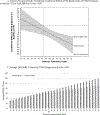Distress tolerance mitigates effects of posttraumatic stress, traumatic brain injury, and blast exposure on psychiatric and health outcomes
- PMID: 37213175
- PMCID: PMC10663379
- DOI: 10.1037/rep0000502
Distress tolerance mitigates effects of posttraumatic stress, traumatic brain injury, and blast exposure on psychiatric and health outcomes
Abstract
Background: Exposure to blasts is common among service members and history of these exposures has been associated with chronic psychiatric and health outcomes. Evidence suggests that distress tolerance (DT) may moderate this relationship and be a valuable treatment target in this population. The purpose of this manuscript was to evaluate DT as a modifying factor in the association between posttraumatic stress disorder (PTSD), mild traumatic brain injury (TBI), blast exposure, and functional indicators.
Method: Participants were 275 (86.55% male) combat veterans who served in Iraq or Afghanistan after September 11, 2001. Clinical interviews for PTSD diagnosis, TBI history, and blast exposure were administered, and participants completed self-report questionnaires (DT, PTSD symptom severity, depressive symptom severity, neurobehavioral symptom severity, sleep quality, pain interference, and quality of life).
Results: DT was significantly associated with all functional indicators beyond PTSD diagnosis, mild TBI, and blast severity. There were significant interaction effects between DT and PTSD diagnosis for posttraumatic stress symptom severity, sleep quality, and quality of life. Specifically, there were significant differences in these reported functional indicators between individuals with and without a PTSD diagnosis as DT increases, such that reported symptoms were lower (quality of life better) for individuals without PTSD as DT improved.
Conclusion: Our results demonstrate that DT might be a key factor in postdeployment function for military service members. Treatments targeting DT may be particularly effective in individuals who attribute psychiatric symptoms to history of blast exposure. (PsycInfo Database Record (c) 2023 APA, all rights reserved).
Figures



Similar articles
-
Effects of blast exposure on psychiatric and health symptoms in combat veterans.J Psychiatr Res. 2021 Nov;143:189-195. doi: 10.1016/j.jpsychires.2021.09.021. Epub 2021 Sep 3. J Psychiatr Res. 2021. PMID: 34500348
-
The Functional Connectome and Long-Term Symptom Presentation Associated With Mild Traumatic Brain Injury and Blast Exposure in Combat Veterans.J Neurotrauma. 2024 Dec;41(23-24):2513-2527. doi: 10.1089/neu.2023.0315. Epub 2024 Sep 20. J Neurotrauma. 2024. PMID: 39150013
-
Factors associated with recovery from posttraumatic stress disorder in combat veterans: The role of deployment mild traumatic brain injury (mTBI).Rehabil Psychol. 2022 Aug;67(3):356-368. doi: 10.1037/rep0000400. Epub 2022 Apr 14. Rehabil Psychol. 2022. PMID: 35420867 Free PMC article.
-
Traumatic brain injury and sleep disturbances in combat-exposed service members and veterans: Where to go next?NeuroRehabilitation. 2019;45(2):163-185. doi: 10.3233/NRE-192804. NeuroRehabilitation. 2019. PMID: 31707378 Review.
-
Military Traumatic Brain Injury: The History, Impact, and Future.J Neurotrauma. 2022 Sep;39(17-18):1133-1145. doi: 10.1089/neu.2022.0103. Epub 2022 Jun 3. J Neurotrauma. 2022. PMID: 35451333 Free PMC article. Review.
Cited by
-
Long Noncoding RNA VLDLR-AS1 Levels in Serum Correlate with Combat-Related Chronic Mild Traumatic Brain Injury and Depression Symptoms in US Veterans.Int J Mol Sci. 2024 Jan 25;25(3):1473. doi: 10.3390/ijms25031473. Int J Mol Sci. 2024. PMID: 38338752 Free PMC article.
References
-
- Belding JN, Jackson JR, Englert RM, et al. Blast Exposure, Traumatic Brain Injury, and Self-Reported Symptomology Among Active Duty Enlisted Marines: An Examination of Post-Deployment Health Assessment Records, 2005–2012. NAVAL HEALTH RESEARCH CENTER SAN DIEGO CA SAN DIEGO United States; 2020. Accessed November 1, 2021. https://apps.dtic.mil/sti/citations/AD1102639
-
- Simons JS, Gaher RM. The distress tolerance scale: Development and validation of a self-report measure. Motivation and Emotion. 2005;29(2):83–102.
MeSH terms
Grants and funding
LinkOut - more resources
Full Text Sources
Medical
Research Materials

